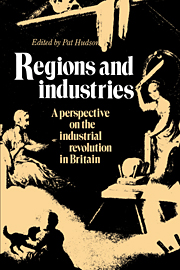Book contents
- Frontmatter
- Contents
- List of figures
- List of maps
- List of tables
- List of contributors
- Acknowledgements
- Introduction
- 1 The regional perspective
- PART ONE THE TEXTILE HEARTLANDS OF THE INDUSTRIAL REVOLUTION
- PART TWO OTHER PATHS, OTHER PATTERNS
- PART THREE THE DIVERSE NATURE OF THE OUTER REGIONS
- 8 Two paths to economic development: Wales and the northeast of England
- 9 Proto-industrialisation in Scotland
- 10 The environment and dynamic of pre-factory industry in Northern Ireland
- Index
9 - Proto-industrialisation in Scotland
from PART THREE - THE DIVERSE NATURE OF THE OUTER REGIONS
Published online by Cambridge University Press: 05 May 2010
- Frontmatter
- Contents
- List of figures
- List of maps
- List of tables
- List of contributors
- Acknowledgements
- Introduction
- 1 The regional perspective
- PART ONE THE TEXTILE HEARTLANDS OF THE INDUSTRIAL REVOLUTION
- PART TWO OTHER PATHS, OTHER PATTERNS
- PART THREE THE DIVERSE NATURE OF THE OUTER REGIONS
- 8 Two paths to economic development: Wales and the northeast of England
- 9 Proto-industrialisation in Scotland
- 10 The environment and dynamic of pre-factory industry in Northern Ireland
- Index
Summary
The origins of the industrial revolution in England have long been debated but Scotland is often treated as only marginally important in the industrialisation of Britain. Scotland's economic development in early modern times remains in many ways a puzzle. An impoverished country with essentially medieval trading patterns and an underdeveloped economy at the end of the seventeenth century, Scotland rapidly caught up with her southern neighbour in the eighteenth century. Scotland's industrialisation has the appearance of an ‘economic miracle’ compared with progress south of the border. Traditionally, Scotland's success has been attributed mainly to external influences, particularly the Union of 1707 giving access to expanding English domestic and colonial markets. To explain everything in terms of the Union is, however, inadequate, as Devine has suggested. Much of Scotland's eighteenth-century development was shaped by indigenous influences but the nature of these has been insufficiently explored.
Scotland's case is not only intrinsically interesting but comparison with England and other European countries offers the possibility of new insights into the causes and mechanisms of industrialisation more generally. Although proto-industrialisation theory has been applied to Ireland, there has been little theoretical work on the development of pre-factory industry in Scotland. Given the recent interest in proto-industrialisation within western Europe and the lack of research on the origins of Scottish industrial development this chapter attempts to analyse some of the distinctive characteristics of Scottish industry in the seventeenth and eighteenth centuries in the hope of generating some new questions about Scottish social and economic development and their place within the British industrial revolution.
- Type
- Chapter
- Information
- Regions and IndustriesA Perspective on the Industrial Revolution in Britain, pp. 228 - 251Publisher: Cambridge University PressPrint publication year: 1989
- 3
- Cited by

